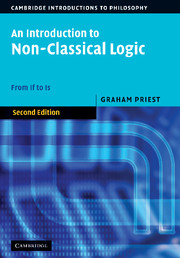Book contents
- Frontmatter
- Contents
- Preface to the First Edition
- Preface to the Second Edition
- Mathematical Prolegomenon
- Part I Propositional Logic
- 1 Classical Logic and the Material Conditional
- 2 Basic Modal Logic
- 3 Normal Modal Logics
- 4 Non-normal Modal Logics; Strict Conditionals
- 5 Conditional Logics
- 6 Intuitionist Logic
- 7 Many-valued Logics
- 8 First Degree Entailment
- 9 Logics with Gaps, Gluts and Worlds
- 10 Relevant Logics
- 11 Fuzzy Logics
- 11a Appendix: Many-valued Modal Logics
- Postscript: An Historical Perspective on Conditionals
- Part II Quantification and Identity
- Postscript: A Methodological Coda
- References
- Index of Names
- Index of Subjects
3 - Normal Modal Logics
Published online by Cambridge University Press: 05 June 2012
- Frontmatter
- Contents
- Preface to the First Edition
- Preface to the Second Edition
- Mathematical Prolegomenon
- Part I Propositional Logic
- 1 Classical Logic and the Material Conditional
- 2 Basic Modal Logic
- 3 Normal Modal Logics
- 4 Non-normal Modal Logics; Strict Conditionals
- 5 Conditional Logics
- 6 Intuitionist Logic
- 7 Many-valued Logics
- 8 First Degree Entailment
- 9 Logics with Gaps, Gluts and Worlds
- 10 Relevant Logics
- 11 Fuzzy Logics
- 11a Appendix: Many-valued Modal Logics
- Postscript: An Historical Perspective on Conditionals
- Part II Quantification and Identity
- Postscript: A Methodological Coda
- References
- Index of Names
- Index of Subjects
Summary
Introduction
3.1.1 In this chapter we look at some well-known extensions of K, the system of modal logic that we considered in the last chapter.
3.1.2 We then look at the question of which systems of modal logic are appropriate for which notions of necessity.
3.1.3 We will end the chapter with a brief look at logics with more than one pair of modal operators, in the shape of tense logic. (This can be skipped without loss of continuity for Part I of the book.)
Semantics for Normal Modal Logics
3.2.1 There are many systems of modal logic. If there is any doubt as to which one is being considered in what follows, we subscript the turnstile (⊧ or ⊢) used. Thus, the consequence relation of K is written as ⊧K.
3.2.2 The most important class of modal logics is the class of normal logics. The basic normal logic is the logic K.
3.2.3 Other normal modal logics are obtained by defining validity in terms of truth preservation in some special class of interpretations. Typically, the special class of interpretations is one containing all and only those interpretations whose accessibility relation, R, satisfies some constraint or other.
- Type
- Chapter
- Information
- An Introduction to Non-Classical LogicFrom If to Is, pp. 36 - 63Publisher: Cambridge University PressPrint publication year: 2008



